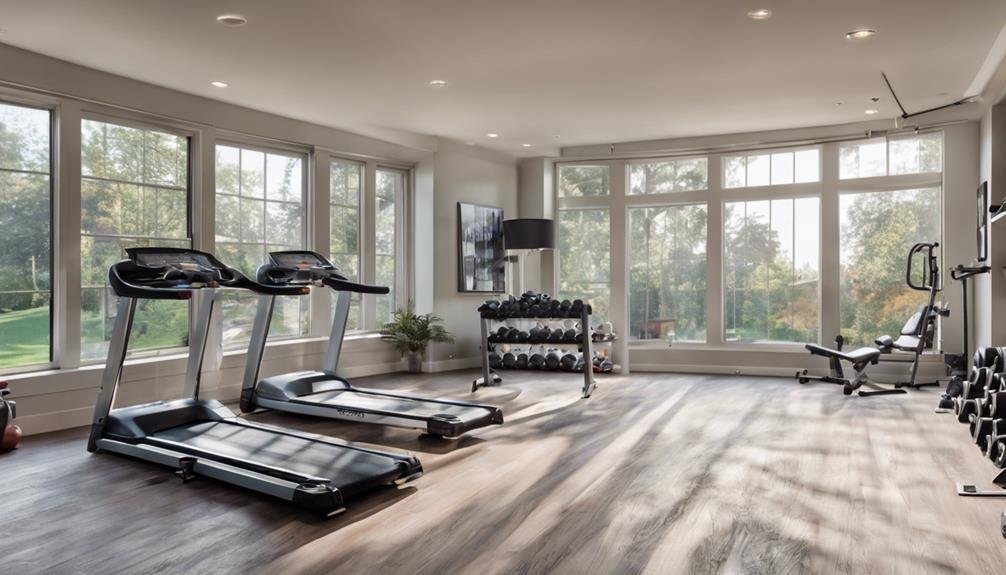
To get in shape and feel your best, you'll want to set realistic fitness goals and track your progress regularly. Create a workout schedule that balances cardio, strength training, and flexibility exercises. Master essential exercises like squats, deadlifts, and bench press, and focus on core stability to improve overall athletic performance. Fuel your body with a balanced diet rich in lean proteins, complex carbohydrates, and healthy fats. Stay motivated by celebrating small victories and finding a workout buddy. By laying this foundation, you'll be on your way to achieving your fitness goals and unlocking a healthier, happier you – but that's just the starting point.
Key Takeaways
- Set specific, measurable, achievable, relevant, and time-bound (SMART) fitness goals to track progress and stay motivated.
- Incorporate a balanced workout routine with cardio, strength training, and flexibility exercises to achieve overall fitness.
- Focus on proper nutrition with a balanced diet rich in lean proteins, complex carbohydrates, and healthy fats to support muscle growth and recovery.
- Prioritize rest and recovery to avoid burnout and injury, aiming for 7-9 hours of sleep and taking rest days as needed.
Setting Realistic Fitness Goals

When setting fitness goals, it's essential to make them specific, measurable, achievable, relevant, and time-bound (SMART) to ensure you're working towards a realistic and attainable objective. By setting SMART goals, you'll be more focused and motivated to achieve success.
For instance, instead of saying 'I want to lose weight,' set a specific goal like 'I will lose 10 pounds in the next 3 months by exercising for 30 minutes, 3 times a week, and eating a balanced diet.'
To stay on track, it's crucial to measure your progress regularly. Track your workouts, weight, and body fat percentage to see how far you've come. This will also help you identify areas that need improvement.
Don't be afraid to adjust your goals if you find they're too challenging or unrealistic. Life can be unpredictable, and your goals may need to change to accommodate new circumstances. By adjusting your goals, you'll avoid frustration and stay motivated to continue working towards your fitness objectives.
Creating a Workout Schedule
Now that you've set realistic fitness goals, it's time to create a workout schedule that helps you achieve them.
You'll need to plan your workout routine carefully, taking into account your goals, fitness level, and available time.
Set Realistic Fitness Goals
As you create a workout schedule, setting realistic fitness goals is crucial to achieving success, since overly ambitious objectives often lead to frustration and abandonment. You want to challenge yourself, but also ensure you're setting yourself up for success.
To start, you'll need to measure your baseline fitness level. This will give you a clear understanding of where you're starting from and help you set achievable goals. Take note of your current weight, body fat percentage, and overall fitness level.
Next, establish milestone goals that are specific, measurable, and attainable. Break down larger goals into smaller, manageable chunks. For example, if you want to lose 20 pounds, aim to lose 1-2 pounds per week. This will help you stay motivated and track your progress. Make sure your goals are also relevant to your lifestyle and priorities. Don't set goals that are unrealistic or unsustainable.
Plan Your Workout Routine
With your realistic fitness goals in place, it's time to create a workout schedule that will help you achieve them, starting with a well-structured routine that balances different types of exercises and allows for adequate rest and recovery.
A good routine should include a mix of cardio, strength training, and flexibility exercises to keep you engaged and prevent plateaus. Consider diversifying exercises to avoid boredom and prevent overuse injuries. For example, if you're a runner, try incorporating strength training exercises to target different muscle groups.
Having a workout schedule also helps you stay accountable and motivated. Consider finding workout partners or joining a fitness group to provide support and encouragement. This can be especially helpful on days when you don't feel like working out.
When creating your schedule, be realistic about your availability and preferences. If you're not a morning person, don't schedule your workouts for 6 am. By planning your workout routine carefully, you'll be more likely to stick to it and achieve your fitness goals.
Remember to review and adjust your schedule regularly to ensure it continues to meet your needs and help you progress towards your goals.
Essential Exercises for Men

You're now ready to incorporate essential exercises into your workout routine.
To build a stronger, leaner body, it's crucial to focus on effective strength training techniques.
In this section, you'll learn about the most efficient exercises to target your core and other key muscle groups, including the best abs exercise moves to help you achieve your fitness goals.
Strength Training Techniques
Mastering five essential strength training techniques is crucial for men who want to achieve a well-rounded physique and improve overall fitness. This means engaging your core, keeping your back straight, and lifting with your legs rather than your back. Proper lifting form not only helps prevent injuries but also ensures that you're targeting the right muscles.
In addition to proper lifting form, it's also important to incorporate muscle recovery techniques into your routine. This can include foam rolling, stretching, and taking rest days as needed. Muscle recovery is just as important as the workout itself, as it allows your muscles to repair and grow stronger.
Some other essential strength training techniques to master include progressive overload, which involves gradually increasing the weight or resistance you're lifting over time. You should also focus on compound exercises such as squats, deadlifts, and bench press, which work multiple muscle groups at once. By incorporating these techniques into your workout routine, you'll be well on your way to achieving a strong and lean physique.
Best Abs Exercise Moves
Having a strong core is essential for men, and achieving defined abs requires a combination of regular exercise, a healthy diet, and low body fat, so it's crucial to incorporate the best abs exercise moves into your workout routine. A strong core improves your overall athletic performance, enhances your posture, and reduces your risk of injury. To get started, focus on core stability exercises that target your entire core, including your abs, obliques, and lower back.
Plank: Hold a plank position for 30-60 seconds to engage your entire core and improve your overall core stability.
Crunches: Perform 10-15 reps of crunches to target your rectus abdominis muscle.
Russian twists: Do 10-15 reps of Russian twists to target your obliques.
Leg raises: Perform 10-15 reps of leg raises to target your lower abs.
Incorporating compound ab movements like these into your workout routine will help you achieve the defined abs you're looking for. Remember to always warm up before your workout and to listen to your body and adjust your routine as needed. With consistent effort and dedication, you'll be on your way to a stronger, leaner core.
Nutrition for Optimal Performance
When it comes to fueling your body for optimal performance, a well-planned nutrition strategy is just as crucial as your workout routine. You can't expect to get the results you want if you're not giving your body the right fuel to support your fitness goals.
A balanced diet that includes nutrient-rich foods is essential for building and repairing muscle tissue, boosting energy levels, and supporting overall health. You should aim to eat a variety of whole foods, including lean proteins, complex carbohydrates, and healthy fats.
Focus on whole grains, fruits, and vegetables, and limit your intake of processed and packaged foods. Protein is particularly important for muscle growth and repair, so make sure you're getting enough from sources like lean meats, fish, eggs, and plant-based options.
Additionally, staying hydrated is crucial for physical performance. Aim to drink at least eight glasses of water per day, and consider adding sports drinks or coconut water to your routine if you're engaging in high-intensity activities.
Staying Motivated and Consistent

By fueling your body with the right foods and staying hydrated, you've laid the groundwork for optimal performance, but now it's time to focus on the mental and emotional aspects of your fitness journey: staying motivated and consistent. This is where many men struggle, but with the right mindset and strategies, you can overcome obstacles and reach your goals.
To maintain exercise consistency, it's essential to find ways to enjoy fitness challenges. Here are four tips to help you stay motivated and on track:
- Set specific and achievable goals: Break down your long-term goals into smaller, manageable tasks to help you stay focused and motivated.
- Find a workout buddy: Exercising with a friend or family member can help you stay accountable and make the experience more enjoyable.
- Track your progress: Use a fitness tracker or log to monitor your progress and celebrate your successes.
- Reward yourself: Treat yourself to something you enjoy after reaching a milestone or completing a challenging workout.
Avoiding Common Fitness Mistakes
As you progress on your fitness journey, it's crucial to recognize and avoid common mistakes that can hinder your progress, lead to injury, or even cause you to abandon your goals altogether. One of the most critical mistakes is neglecting recovery. Getting enough rest and managing stress levels are essential for muscle growth and repair.
| Mistake | Consequence |
|---|---|
| Insufficient rest | Muscle fatigue, decreased performance |
| Poor stress management | Increased cortisol levels, weight gain |
| Inconsistent workout routine | Plateaus, lack of progress |
| Unrealistic expectations | Frustration, burnout |
Don't fall into the trap of overtraining or neglecting your mental well-being. Make sure to prioritize rest and stress management alongside your workout routine. Aim for 7-9 hours of sleep each night and engage in stress-reducing activities such as meditation or yoga. By avoiding these common mistakes, you'll be able to stay on track, achieve your fitness goals, and feel your best. Remember, fitness is a journey, not a destination. Stay focused, stay consistent, and you'll be on your way to a healthier, happier you.
Building a Home Gym Routine

Now that you're aware of the common mistakes to avoid, let's focus on creating an effective home gym routine that fits your lifestyle and goals. Having a well-planned routine is essential to achieving your fitness objectives.
To get started, you'll need to invest in some effective workout equipment that suits your needs and budget. Some budget-friendly home options to consider include:
- Adjustable dumbbells: A versatile and space-saving option that can be used for a variety of exercises.
- Resistance bands: Lightweight, portable, and affordable, resistance bands are perfect for strength training.
- Foldable bench: A compact and convenient option for those who want to work on their upper body.
- Jump rope: A classic cardio exercise that's easy on the wallet and can be done anywhere.
When selecting equipment, think about your fitness goals and the types of exercises you want to do. It's also essential to choose equipment that's durable and easy to use. By investing in the right gear and creating a routine that works for you, you'll be on your way to a healthier, stronger you.
Tracking Progress and Success
To effectively track your progress and success, you'll need to establish clear goals and metrics for measuring your achievements, whether it's through regular weight checks, body fat percentage monitoring, or progress photos. This will help you stay motivated and focused on your fitness journey.
When measuring progress, it's essential to track health metrics that matter to you, such as your resting heart rate, blood pressure, or body mass index (BMI). You can use a fitness tracker, mobile app, or spreadsheet to log your progress and identify patterns.
Regularly tracking your progress allows you to make adjustments to your workout routine and nutrition plan as needed. It's also a great way to celebrate your successes and stay accountable.
Consider taking progress photos every four to six weeks to visualize your transformation. Remember, tracking progress isn't just about the numbers; it's about how you feel and the progress you're making towards your goals.
Conclusion
As you reach the end of your fitness journey, imagine yourself standing in front of a mirror, admiring the results of your hard work. You're stronger, leaner, and more confident.
You feel the rush of endorphins after a killer workout, and the satisfaction of crushing your goals. Your fitness transformation isn't just physical – it's mental and emotional too.
You're now equipped with the knowledge and habits to maintain a healthy, balanced lifestyle.
